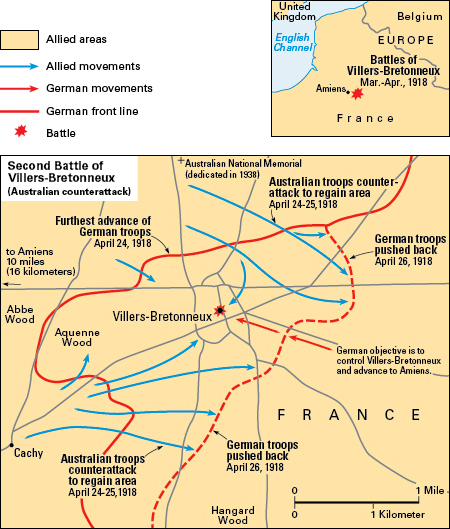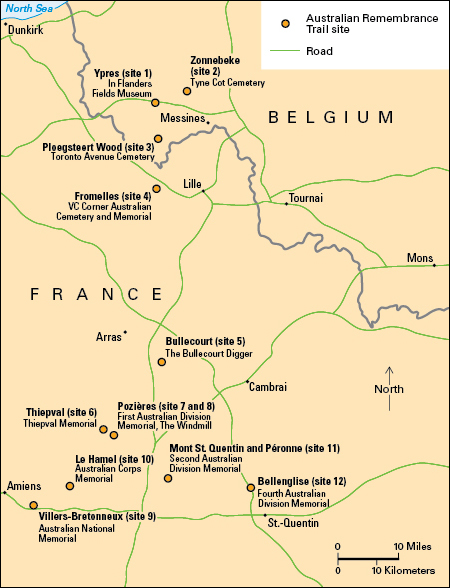
Villers-Bretonneux, Battles of, were fought between Allied and German forces in northern France during World War I (1914-1918). The two battles took place in April 1918 near the village of Villers-Bretonneux, some 10 miles (16 kilometers) east of Amiens . In the first battle, Allied troops repelled a German assault on the village. In the second battle, German troops took Villers-Bretonneux. Allied troops rallied, however, and reclaimed the village.
Allied troops in the battles were British , Australian , and French. The French forces included the Moroccan Division, a unit made up of troops from French colonies in Africa and the French Army’s Foreign Legion .
Background.
On March 21, 1918, Germany launched a massive offensive on the Western Front, the battlefront that stretched through Belgium and northern France (see German Spring Offensive ). One of Germany’s main goals in the offensive was the capture of Amiens. At that time, Amiens was an important Allied rail, communications, and supply center. To reach Amiens, however, the Germans had to break the Allied defenses centered on Villers-Bretonneux.
The First Battle of Villers-Bretonneux.
On March 30, German troops attacked Allied lines near Villers-Bretonneux. Allied troops fell back, but counterattacks quickly stopped the German advance. On April 4, the main battle began as Germans renewed the attack, advancing along a front extending both north and south of Villers-Bretonneux. After heavy fighting, they reached the edge of the village. Further German assaults failed, however, and Allied counterattacks ended the battle late on April 5.
The Second Battle of Villers-Bretonneux.
On April 24, the Germans attacked Villers-Bretonneux again. German artillery (heavy guns) pounded the Allied lines, using large amounts of poison gas. German flame throwers (devices that shoot streams of burning fuel) and tanks supported the attack, helping break the Allied defenses. British tanks exchanged fire with German tanks during the battle—the first time enemy tanks fought on a battlefield. German forces took Villers-Bretonneux and pushed beyond the village into nearby woods. German attacks also drove the Allies back to the north and south of Villers-Bretonneux.

Later that night, Allied troops counterattacked. After heavy fighting through the night, Australian troops retook much of Villers-Bretonneux. Allied counterattacks continued through April 26, including a particularly costly attack made by the French Moroccan Division. Allied troops cleared the Germans from Villers-Bretonneux, but fighting near the village continued for several days.
Aftermath.
Because the Battles of Villers-Bretonneux helped prevent attacks on Amiens, they are considered Allied victories. However, the battles themselves ended in a stalemate, with Allied and German lines ending roughly where they began. Still, the stubborn Allied defense at Villers-Bretonneux played a key role in stopping the overall German offensive.

The British and Germans each suffered more than 10,000 casualties (people killed, wounded, missing, or captured) in the two battles. French casualties—almost entirely in the second battle—numbered nearly 3,500. The Australians suffered more than 600 casualties in the first battle, and another 2,400—including 1,200 killed—in the second.
The Australian National Memorial at Villers-Bretonneux, located on a hill just north of the village, was dedicated in 1938. The memorial commemorates the nearly 11,000 Australians who died on the Western Front but have no known graves. More than 46,000 Australians were killed in France and Belgium during the war. Another 134,000 were wounded or captured.
